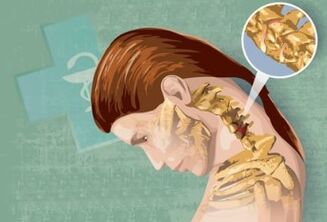In the modern world, resonance of cervical osteochondrosis disease is difficult to assess.Cervical area osteochondrosis is much more common than other vertebrates.The disease, up to one degree or another, has almost everyone over twenty -five years old.

Cervical osteochondrosis develops mainly due to an inactive lifestyle, which is mainly facilitated by the transition of a person's history from physical to mental labor, which, even at a moderate level, accompanies work performance in sitting position.
Cervical spinal osteochondrosis is a degenerative-dystrophic cervical spinal disease, leading to damage to the intervertebral disc, which is common in osteochondrosis.Because the spinal cord is caused by its relatively portable properties, but is also exposed to the less developed muscle corset, so any negative effects on the neck or back, do not affect the cervical area well.Because degenerative changes are most often developed in the most portable vertebrate, the nerve endings at the C5 level ... C7 are most often suffering in the cervical region.
Because the symptoms of cervical osteochondrosis are so contradictory, they are not always considered just as symptoms of the disease, which often leads to other medical treatment for help.Consider them no more details.
Cervical osteochondrosis and symptoms
Because the cervical spine is relatively dense, compared to its other departments, it does not even have a great deal of tension of the muscles -The she or the cervical region vertebra, it can cause squeezing or pinching the nerve roots, which can also be applied to the vessels located in this section.Well, osteophytes are bone growth, in the treatment of people called "salt deposits" and formed in the development of cervical osteochondrosis, leading, as a result, only for significant deterioration in the course of the disease.
Clinical manifestations of cervical osteochondrosis disease, namely, symptoms, can be divided into reflex symptoms and radicular symptoms of cervical osteochondrosis.
Symptoms of cervical osteochondrosis reflexes
Symptoms of cervical osteochondrosis reflexes include the mentioned "shots", which are expressed in the appearance of acute acute pain in the neck, and are very intensive in any movement.Given this, patients often take some forced, most comfortable, head.In addition, the appearance of normal "Christ" during turn or other head movements is also possible.

In the case of cervical osteochondrosis, patients often experience compression headaches and irradium in the eyeball or temporal head.In addition, sometimes at the same time, the severity of visual perception may fall, as if "everything floated in front of my eyes."
The vertebral artery syndrome can also develop, when the nerve plexus is threatened, which is very frequent, due to dizziness in the patient, is incorrectly diagnosed with disorders in the blood circulation of the brain.Symptoms of cervical osteochondrosis can be manifested with sharp movements of the head and complicate nausea and the possibility of vomiting.
In addition to the above, the symptoms of cervical osteochondrosis reflex also include cardiological syndrome where sensations arise similar to angina attacks.But the manifestation of symptoms of osteochondrosis is usually combined with complex signs and other diseases, so it usually does not cause difficulties in making the right diagnosis.
Symptoms of cervical osteochondrosis rim
Radicular symptoms of cervical osteochondrosis, as a rule, arise due to the ending of the spinal cord - the spine.In this case, sensitive disorders that affect motor function depend entirely on the injured nerve root, namely:
- C1 - a decrease in sensitivity in nape;
- C2 - pain in the parietal or occipital area;
- C3 - impaired sensitivity and the appearance of pain in the neck, where spinal trauma occurs with highly affected speech functions, due to loss of language sensitivity and controlling it;
- C4-The appearance of pain and decreased sensitivity in the shoulder-lopate spine, as well as pain in the heart and liver, with simultaneous decrease in neck muscle tone and possible respiratory disorders;
- C5 - a decrease in sensitivity and pain in the outer shoulder surface;
- C6-Pain, Irradium from the cervical spatula, the outer surface of the shoulder, the lower arm, and then from the ray to the thumb;
- C7-same pain as C6, but irradium from the shoulder blade behind the shoulder, and then from the lower arm to 2.4 fingers, with a decrease in sensitivity in the area of the pain;
- C8 - a decrease in sensitivity and pain from the neck on the shoulder, and then from the lower arm to the small finger.

Cervical osteochondrosis and its treatment
Cervical osteochondrosis is a very complicated and very unpleasant disease, for systematic treatment, duration and stage are required.Therapeutic treatment of cervical osteochondrosis, first of all, aims to stop the symptoms of cervical osteochondrosis pain and the removal of inflammation in the neck affected by the disease.
Patients, in the treatment of cervical osteochondrosis, are performed by classical analgesics.Although recently in the treatment of cervical spinal osteochondrosis, anti -anti -unstable medications effectively relieve pain and reduce inflammation, in the treatment of spinal osteochondrosis.
Among other things, chondroproprotectors are also used in the treatment of cervical osteochondrosis, which slows down the process of destroying cartilage tissue and, according to many experts who also contribute to the regeneration process.In addition, patients are prescribed by the use of B vitamins that improve metabolic processes in the patient's body.
But the use of external gel or ointment for the treatment of cervical osteochondrosis is ineffective, but the meaning, because in the process of rubbing into the skin of the cervical spine supplement is also performed.
In addition to traditional drug treatment for cervical osteochondrosis, physiotherapy procedures are, and in particular, the use of magnetotherapy is very effective through special medical devices, for example, domestic devices that have had good glory among experts and patients.It is also used, in addition to the above, therapeutic massage, physiotherapy training and manual therapy.However, in cases of severe the disease, surgical intervention may be needed.
Prevention of cervical osteochondrosis disease
The prevention of cervical osteochondrosis itself is not complicated.Recommended:
- Perform an active and healthy lifestyle,
- play sports, or at least morning gymnastics,
- efficient organization at work,
- Compliance with the work regime and rest,
- With prolonged work in the sitting position - during work hours, do a few warm times and make sure the head and posture are properly working.
Selection of comfortable pillows and mattresses for sleeping is also important.But for those who have suffered from the disease, the use of a day for comfortable sleep with specialized orthopedic products is highly recommended.



















